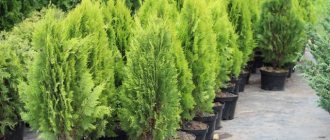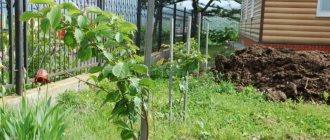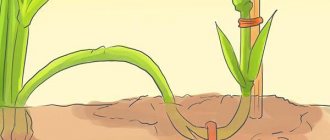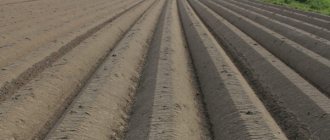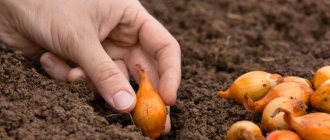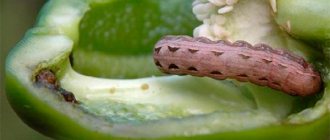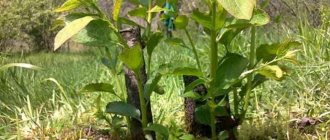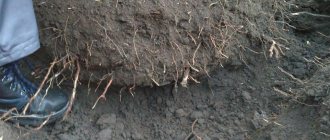Growing a healthy fruit-bearing garden is the dream of any land owner. To do this, it is necessary to provide all trees with sufficient light, otherwise one can only dream of good harvests, the trees will get sick and be damaged by pests. To prevent this from happening, it is necessary to maintain a certain distance between all fruit trees. How to do this in a limited area of a standard dacha? To solve this problem, you need to plan the placement of crops taking into account all the needs and nuances.
How to determine the required distance
In addition to the demands on light, you need to take into account the fact that when planting close together, the root systems of trees come into contact with each other. As a result, some of them will lack nutrients. After all, a stronger plant will take them away from a weaker one. A distance must be maintained from the house, outbuildings and fence, at least equal to the height of the tree itself. A falling tree, even with its top, can cause serious damage to buildings.
When calculating the spacing between trees, it is necessary to take into account how they will grow in the future. Therefore, when purchasing a seedling, you need to ask the seller in detail about the characteristics of the variety. It is best to buy planting material in trusted places and nurseries. When purchasing a seedling “from hand”, you cannot be sure that the variety will correspond to the declared one.
So, at what distance should fruit trees be planted from each other?
- tall trees, such as vigorous apple trees, pears, apricots, and cherries, should preferably be planted closer than 5-6 m from each other;
- cherries, plums, dwarf pears and apple trees - 3-4 m;
- columnar apple trees - 2 m.
At what distance should fruit trees be planted from each other?
While the trees are small, the spaces between the rows can be occupied by berry bushes or garden crops. Gardeners often use currants and gooseberries for this, as well as strawberries, potatoes and root vegetables. The only nuance in this case is that you cannot occupy the tree trunks; this is at least a meter in diameter.
Features of care
The pear requires a little attention. She needs care and attention, which also applies to distance. So, the root system of a tree is very impressive and you need to think about this when planting vegetables near the tree and conducting communications.
The large crown size can be slightly reduced and reduced by pruning. Of course, this does not mean that it will be possible to reduce the occupied area by half, but it will be possible to slightly reduce their scope.
You also need to take into account the size of the tree when watering and fertilizing. Powerful roots are located widely around the perimeter and go deep. Therefore, watering into a special roller in the tree trunk also implies a sufficient amount of water.
How to make a planting plan
At what distance should apple trees be planted from each other?
To understand how to properly plant fruit trees in a garden plot, you need to study your summer cottage plot. You need to know the location of groundwater on it, take into account your own and neighbors’ buildings, be sure to take into account the cardinal directions, power lines, and the direction of the prevailing and cold winds. Next, a sheet of paper is taken, and all of the above objects are noted in great detail. After this, you should decide what percentage of the total area of the remaining space can be given to the garden. This is, as a rule, the more northern part of the site, so that trees do not block future beds. Next, you need to decide what kind of fruit and berry crops are needed, how many early, mid-season, and late varieties are needed. Choose the varieties you like and write down the approximate height of each of them.
Orchard scheme for planting bushes and trees according to a stepwise planting system:
- To the north are tall trees;
- closer to the south - medium height;
- then – low;
- on the southernmost side there will be strawberries and garden crops.
How to make a compatibility planting plan
The modern trend towards landscape design involves planting a garden in the form of curtains, hedges, single plantings on the lawn, and round gardens. Planning such a placement will require more work and knowledge. If possible, it is better to entrust this matter to professionals in order to avoid mistakes and get high-level results.
What trees to plant behind the fence
Planting plants along the fence serves several functions: it serves as a hedge, and also decorates the landscape and protects the area from dust and prying eyes. To do this, you can choose climbing plants that create a beautiful aesthetic appearance and do not form a shadow: wild grapes, hops, clematis. In the yard near the fence you can plant:
- yew;
- fir;
- rowan
It is recommended to plant flowering shrubs or low-growing trees on the street side near the fence:
- low-growing thujas;
- lilac;
- rowan;
- maple;
- chestnut;
- birch trees
Regardless of landscape design and composition, first of all the requirements specified in SNiP must be observed.
Rules for arranging seedlings according to cardinal directions
Video: At what distance to plant apple trees from each other
Most fruit crops are light-loving. Rowan, barberry, gooseberry, raspberry, rose hip, black currant can tolerate slight shading. Grapes are a very heat-loving plant; they can be placed near a building or fence on the south or southwest side. Peach, apricot, pear, plum, apple trees need a lot of light. They are planted in the south and southwest. Black currants can be placed at the northern border of the site. Red currants and gooseberries - from the western or eastern side. Bushes can also be placed between seedlings of long-growing fruit trees, remembering the rule: the lifespan of berries is about 12-15 years. Then the tree branches will close together, and it won’t be possible to place anything between them.
Resistant varieties of cherries and plums can be located along the movement of the prevailing wind. They will act as a barrier to less resistant crops. In addition, taking into account prevailing winds, self-sterile varieties are planted so that pollinators are in front of them.
Nuances of garden space planning
So, when the idea of having your own garden with fruit trees and a full set of shrubs has already matured, it is worth considering a plan for planting and placing the garden.
One of the planting options, taking into account the optimal distance between fruit trees, may be a stepped planting scheme. According to this scheme, plantings are located depending on height and the need for heat and light. Visually it might look like this:
- The northern side of the site has tall fruit trees;
- To the south - medium-sized trees, stone fruit or early varieties of apple and pear trees;
- Even further south there are low-growing trees and shrubs;
- On the southern side of the site there are vegetable crops, strawberries, and melons.
In the south, you need to plant thin trees and shrubs.
Depending on the location of garden buildings, you can determine the place most protected from the winds - here you can plant heat-loving peach or apricot. And in order to provide shade in the courtyard on a hot day, it is recommended to plant a walnut - with its crown it will perfectly cover the entire area underneath from the sun.
And of course, before planning planting, you need to assess the site - for many sites, before you start planting a garden, you will have to do a lot of work to clean up the site. It is especially difficult to grow a garden on swampy lands and where the groundwater level rises almost to the ground; drainage and reclamation are indispensable.
https://youtube.com/watch?v=mim1_RTPfJQ
Growing a healthy fruit-bearing garden is the dream of any land owner. To do this, it is necessary to provide all trees with sufficient light, otherwise one can only dream of good harvests, the trees will get sick and be damaged by pests. To prevent this from happening, it is necessary to maintain a certain distance between all fruit trees. How to do this in a limited area of a standard dacha? To solve this problem, you need to plan the placement of crops taking into account all the needs and nuances.
Distance to fence with neighbors
Distance to fence with neighbors
At what distance to plant onions?
Equally important when planting trees and shrubs is the proximity of the fence to neighbors. There is a law on “Planning and development of the territory of gardening (dacha) associations of citizens,” which states that the distance to the neighboring plot is at least 4 m for tall trees, 2 m for medium-sized trees and 1 m for shrubs. You also need to take into account the neighbor’s house: there must be at least 5 m from it to a tall tree. The law is the law, but in practice, fruit trees often grow right on the border of the plot. Usually this suits both parties, since the neighbors are provided with fruit from them. But when the tree gets old and begins to pose a threat, then conflict will not be avoided. Therefore, it is better to keep the interval.
On a semi-dwarf rootstock
Semi-dwarf apple trees differ from dwarf apple trees in that they have greater crown growth power .
If, when planting an apple orchard, seedlings on a semi-dwarf rootstock or low-growing species , the grafting of which was carried out on the basis of seedlings, then the shortest distance should be at least three meters, and from row to row - approximately 5 meters.
If the size of the apple tree plantings is large, then it is necessary to plant using a “map” . This is when 10 rows are planted on an area of 50 by 100 meters, 5 meters between the rows, inside the trees themselves are placed at a distance of at least 375 cm, but it is better to focus on 400-450 cm.
Layout of columnar apple trees.
With this placement, further care will be simplified, and the garden will not turn into a forest over time .
When you need to plant no more than 10 semi-dwarf seedlings, the distance between the apple trees when planting is 4.5 meters between each other, and also between the rows. This will guarantee free and easy movement of gardening equipment around the site, and the owners themselves with their children.
If the varieties are vigorous , then the distance from apple tree to apple tree should be increased to five meters, but if they are not going to take special care of the garden, then 5.5 meters can be allocated. Since uncontrolled overgrowth of such trees is a very real thing.
How to arrange trees on 10 acres
The first step is to take a sheet of graph paper and draw a site plan on a convenient scale.
It is customary to divide the estate into the following zones:
- Living sector. Includes the house and surrounding area.
- Rest zone. Usually located inside the site.
- Garden. As a rule, it occupies the largest space.
- Economic part. Sheds for storing equipment and pets.
Existing and planned paths, fences, fences, and underground communications are also noted. It is also necessary to note on the plan the wind rose and the relief of the site. Planting must also be planned taking into account the border with neighbors. The garden, as a rule, occupies the northern or northeastern part, but it all depends on the location of the particular site. It is quite possible to occupy the border of a dacha with fruit trees, provided that the distance between tall apple trees, pears, cherries and the fence is 4 m, for plums and other short trees - 3 m, for shrubs - 1 m.
Distance between young and old apple tree
In some cases, a gardener has to plant a young tree near an old apple tree. To determine the required distance between two copies, factors such as:
- variety;
- fruiting period;
- branching type.
It is advisable to plant specimens that are similar in terms of fruiting period and growth vigor. It is unacceptable to place a new tree directly on the site of the old one, or 2 m around it. In the northern territories, the distance in the rows should be as follows:
- from 5 to 7 m – for tall apple trees;
- from 4 to 5 m – for medium varieties;
- about 3 m – for dwarf trees.
Compatibility of fruit trees and berry gardens
It would be good if crop compatibility was taken into account when planning plantings. The fact is that plants secrete various substances that, when released into the soil, can inhibit the crop growing nearby.
Trees of the same species are considered ideal neighbors. But in an amateur garden it is rarely impossible to plant separate pear trees, separate apple trees, etc. Moreover, there are usually 1 to 3 copies of each species. The minimum distance to the antagonist crop is 4 m.
Compatibility table for fruit trees and berry bushes
| Culture | Favorable interaction | Undesirable neighborhood |
| Apple tree | raspberries (until the apple tree grows), honeysuckle, quince | all berry bushes, all stone fruits |
| pear | rowan, currant, apple tree, grapes | barberry, juniper, cherry, sweet cherry |
| cherry | cherry, plum | rowan, nightshade |
| plum | elder | pear, apple tree, raspberry, black currant |
| apricot | dogwood | apple tree, pear tree, plum tree, peach tree, cherry tree |
| peach | apricot | apple tree, pear tree, cherry tree |
What to consider when landing
You should not plant crops that do not grow well in your climate. They will require a lot of attention, effort and time, and the result may be disappointing. Then you will have to cut down and uproot them, replace them with more suitable ones and wait for them to grow. It is best to initially choose the planting material that will ensure a reliable future for the garden.
With proper crown formation, a maximum of 15 trees can fit on one acre. If pruning is not carried out, then half as much. The exception is columnar forms, which can be planted at intervals of 1 m. The ideal arrangement of rows of garden crops is from south to north in height. In the middle between the rows you can grow shade-tolerant crops.
Orchard
If enough space is allocated to the garden, then it is better to plant the berry bushes separately from the trees, since later problems may arise when spraying the trees at a time when the bushes can no longer be processed.
If there were old trees on the plots that were removed, then this needs to be taken into account when planning new plantings. Over the course of its life, a tree selects the nutrients it needs from the soil, and soil fatigue occurs. In addition, diseases and pests characteristic of this type of crop accumulate in the area where it grows. Therefore, it is important to observe the so-called garden rotation.
There are several principles for proper crop rotation in the garden:
- You cannot plant a new tree of the same species in the place of an old tree. That is, after the apple tree, you cannot plant an apple tree.
- At least 5 years must pass between planting a crop of the same type as the previous one.
- It is not advisable to plant crops from the same family one after another. For example, after stone fruits it is better to plant pome fruits and vice versa.
- To reduce soil fatigue, you can clear the fertile layer of soil (30 cm) from the roots of an old tree.
- Another way to restore the soil is to sow green manure in this place: rapeseed, soybeans, buckwheat.
- In place of the removed crop, you can grow vegetables, herbs or perennial herbs.
Disputes and ways to resolve them
Of course, the legislation provides ways to resolve a variety of disputes related to improper landscaping and other violations of the rights of neighbors. According to it, both parties must first make certain efforts to independently resolve disputes. If you can’t resolve the issue on your own, then you will have to contact local authorities.
When contacting, one of the parties to the conflict provides a written statement indicating the existing problem. Local self-government bodies are required to respond within 10 days from the date of receipt of such a request. Conduct an examination and provide a written response on the subject of the dispute.
In most cases, if green spaces do not meet existing standards, they will either need to be replanted or cut down when otherwise is not possible. Responsibility for the implementation of the decision rests with the party to the conflict on whose territory the incorrectly planted trees grow.
In rare cases, when a heavily overgrown tree meets sanitary standards and all distances are maintained correctly, but part of its crown or root system moves onto a neighbor’s property, he has the right to saw down the crown over his territory and also get rid of part of the roots. But at your own expense and on your own.
How to place a garden in a small area
Tips from experienced gardeners for growing fruit trees in a small garden:
- The most logical solution for a small garden is dwarf trees. They can be grown at an interval of 1 m between trees and 2 meters in a row. At the same time, they begin to bear fruit earlier than tall varieties.
- Another option is grafting on low-growing tree species. The most winter-hardy rootstock is cotoneaster; it grows well both in the Moscow region and Leningrad region, as well as in the Urals and Siberia. Even a pear on it will grow no higher than 2 m. However, a grafted tree requires slightly different care than an ordinary rooted plant.
- Experienced owners of small gardens advise placing trees in a checkerboard pattern. At the same time, the norm of spacing between trees is maintained, and row spacing is reduced.
- Also, in a small garden with dense plantings, proper pruning is required. It is necessary to form compact crowns that will not intertwine branches with nearby growing trees.
- It is better to choose the most proven varieties of fruit and berry crops for a small garden. This will help avoid “downtime”, when such expensive square meters will not produce results due to the fact that the selected variety does not bear fruit for several years.
0 0 vote
Article rating
